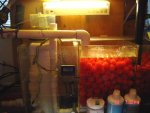A
Anonymous
Guest
Ok, So I have bioballs in my sump. I understand the potential for Nitrites. My question is why wouldn't LR in the sump (potentially) cause higher nitrites?
Both are esentially surface area for bacteria growth, so should the bacteria notice any difference between the two?
Also, my bioballs are not submersed in the sump. They sit in an egg crate set up above the water level in the sump. The overflow flows over them to soften the sound and prevent losta bubbles from entering the skimmer pump and return pump. Will this minimalize my potential for Nitrate Probs?
90 reef (very low bio-load right now) w/ sump and skimmer
~ 100 lbs live rock + 2-3" sand bed.
Both are esentially surface area for bacteria growth, so should the bacteria notice any difference between the two?
Also, my bioballs are not submersed in the sump. They sit in an egg crate set up above the water level in the sump. The overflow flows over them to soften the sound and prevent losta bubbles from entering the skimmer pump and return pump. Will this minimalize my potential for Nitrate Probs?
90 reef (very low bio-load right now) w/ sump and skimmer
~ 100 lbs live rock + 2-3" sand bed.






